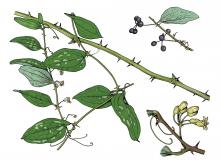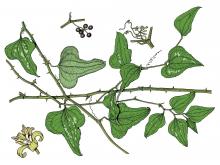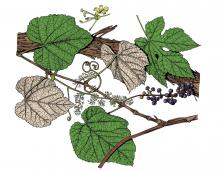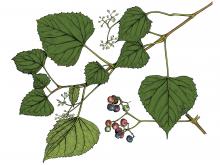Trees, Shrubs and Woody Vines
Media

Species Types
Scientific Name
Toxicodendron radicans
Description
Poison ivy is a toxic plant that contains an oil in all its parts that, if you come into contact with it, can cause an intense skin reaction. Learn to recognize it, and sidestep it on your outings.
Media

Species Types
Scientific Name
Parthenocissus vitacea (syn. P. inserta)
Description
Woodbine is a climbing woody vine that usually sprawls over bushes and rocks. Its leaves have five coarsely toothed leaflets. Unlike the closely related Virginia creeper, its tendrils generally lack sucker disks. It is rarely found in Missouri.
Media

Species Types
Scientific Name
Ceanothus americanus
Description
A very small shrub of our native prairies and other open sites, New Jersey tea was used by patriotic American colonists as a substitute for black tea imported from England during the Revolutionary War.
Media

Species Types
Scientific Name
Ribes missouriense
Description
Missouri gooseberry is our state’s most widespread and common gooseberry. People brave its prickly stems to collect its tart, tasty fruits to make pies, jams, and jellies.
Media

Species Types
Scientific Name
Nandina domestica
Description
Heavenly bamboo is hardly “heavenly” when it comes to its negative effects on our native plants and animals. A tremendously popular landscaping plant, it readily escapes and is difficult to eradicate.
Media

Species Types
Scientific Name
Smilax hispida (syn. S. tamnoides var. hispida)
Description
Bristly greenbrier is a stout woody vine with bristlelike black spines, climbing high by tendrils to a length of 40 feet. It is the most common greenbrier in Missouri and is found statewide.
Media

Species Types
Scientific Name
Smilax glauca
Description
Greenbrier is a slender, spiny, woody vine climbing by coiled tendrils. Its leaves can be broadly heart-shaped, oval, or lance-shaped. The leaf undersurface is smooth and notably whitened, silvery, or blue-gray with a waxy coating.
Media

Species Types
Scientific Name
Smilax bona-nox
Description
Catbrier is a green-stalked perennial vine with stout spines. It climbs up to 25 feet using tendrils that arise in pairs from the bases of the triangular, heart, or fiddle-shaped leaves.
Media

Species Types
Scientific Name
Vitis aestivalis
Description
Summer grape is a vigorous, woody, wild grapevine climbing to a height of 35 feet. It grows mostly in the southern two-thirds of Missouri, often in drier situations than many other grape species.
Media

Species Types
Scientific Name
Ampelopsis cordata
Description
Raccoon grape is a woody vine climbing by tendrils to a length of 60 feet. The most aggressive native vine in the state, it can smother small- to medium-sized trees.
See Also
About Trees, Shrubs and Woody Vines in Missouri
There are no sharp dividing lines between trees, shrubs, and woody vines, or even between woody and nonwoody plants. “Wood” is a type of tissue made of cellulose and lignin that many plants develop as they mature — whether they are “woody” or not. Trees are woody plants over 13 feet tall with a single trunk. Shrubs are less than 13 feet tall, with multiple stems. Vines require support or else sprawl over the ground.





















